






















Marketing transformation can pay off in a big way. Studies show that combining smart strategies and investments can deliver a 14% higher market cap. For Fortune 500 firms, this could give them a $2.75 trillion advantage over their competitors.
Major brands are using digital platforms, customer analytics, and generative AI to rewire how they drive customer engagement and improve customer service. These capabilities are helping companies respond to shifting market dynamics and strengthen brand presence.
Reinventing a company’s entire marketing strategy from the ground up sounds like a bad idea. But some of the biggest companies in the world are shifting their marketing focus to ramp up their profits. Seven out of ten organizations are either rolling out a digital transformation strategy or working on putting one together.
You don’t want to get left behind.
Fieldtrip helps brands rethink how they connect with their customers.
We combine customer analytics, generative AI, and immersive experiences to create strategies that improve engagement, drive revenue, and strengthen loyalty on different digital platforms.
Want to know how marketing transformation works? Let’s dig into it.
Top tip: Start with a pilot that tracks customer analytics and net promoter score in a simple scorecard system. After 90 days, you can refine your digital marketing and customer service decisions based on real data.
Fortune 500 brands achieve up to 14% higher market cap through strategic marketing transformation.
Companies like Nike, Amazon, and Nestlé use AI, data, and customer analytics to improve engagement and strengthen loyalty.
Customer expectations drive transformation: people want instant, personalized, and seamless experiences.
Market disruption pushes large enterprises to adapt fast or lose share to agile competitors.
CMOs lead the charge by aligning marketing with technology, data, and talent across business functions.
Successful transformation relies on three pillars:
Core technologies include AI, AR, automation, blockchain, and NFTs, all tied into CRM and analytics for measurable ROI.
Transformation at scale depends on:
Case studies show real results:
Future strategies focus on:
Fieldtrip helps enterprises execute these transformations through customer analytics, AI integration, and immersive experiences.
Start small, measure impact, and scale what works to unlock sustained growth and stronger customer relationships.
You can’t ignore marketing transformation because rising customer expectations demand seamless, personalized, instant experiences. Market disruption also pushes you further. Failure to adapt means lost revenue and share.
Now let’s see exactly how customer expectations are evolving.
People now expect seamless experiences across digital and physical channels, instant responses from support teams (at least 77% of them do), and personalized interactions that feel authentic.
Businesses that fail to adapt risk losing customers, relevance, and revenue.
That’s why the digital transformation market is expected to grow at a CAGR of 22%.
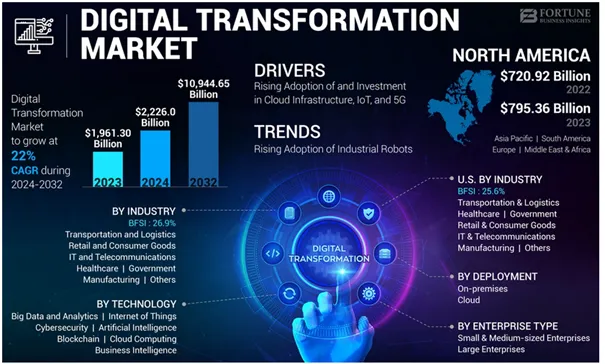
Customer attention has also shifted.
Demand for transparency is also growing.
Large brands operating in diverse regions recognize that influence networks and data collection must go hand in hand with employee development to close skill gaps and meet these expectations.
Fortune 500 companies may get just the headlines, but we implement these principles: quick adaptation, integrated technology, and cross-functional collaboration to drive growth.
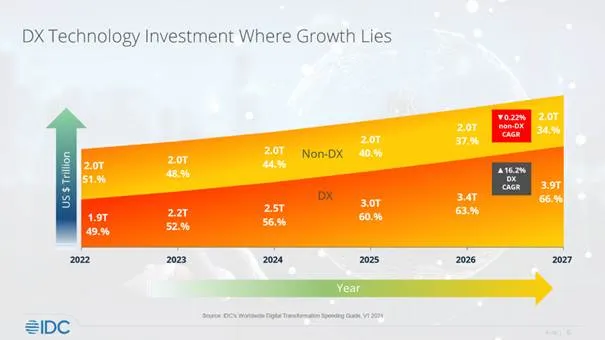
Staying still leaves companies exposed to erosion in market share. You may also face the kind of pressure that can lead to product diversification missteps or underinvested research and development.
Competitive players use automated solutions and collaborative planning across logistics activities and supply chain strategy to move faster.
Relevance today depends on rethinking category dynamics, using cross-category expertise, and layering in smart-farming software or other sector-specific technologies relevant to brand innovation.
Leaders who treat marketing transformation as an optional risk diminish net promoter score and weaken brand presence.
After all, marketing transformation improves brand image.
And that’s correlated with significantly higher NPS (r = 0.55–0.68). More importantly, the top NPS performers can grow over 2× faster than competitors.
For a multinational consumer goods organization, missing this opportunity could mean losing valuable digital revenue streams and eroding trust across markets. Continuous reinvention supports business transformation and long-term success.
The growing ad spend (which is projected to reach nearly $1 trillion by 2028) shows you why this is such a pressing matter.
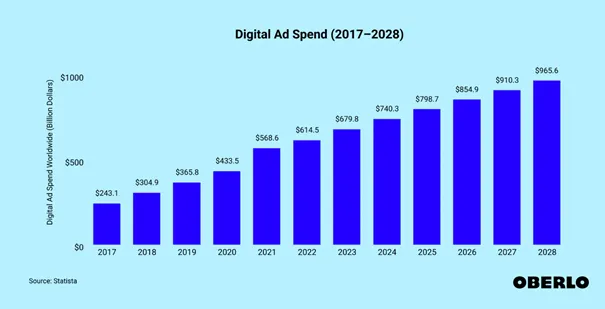
You’ll be facing rising costs and more competition for attention. Without smart marketing transformation, you can’t maximize your ad budget.
Here’s one potential way out.
At Fieldtrip, we map customer journeys across every touchpoint, combining analytics with influencer content. Our main goal is to help brands deliver experiences that deepen engagement and boost loyalty.
This approach works extremely well for global, enterprise-level brands.
Hint: We’ll share a few examples in a minute.
Collecting the right data is, of course, critical. That’s why we advise you to choose carefully between media mix modeling vs multi-touch attribution.
Influence networks help amplify word-of-mouth, but those conversations depend on the full customer experience from product design to delivery. That’s why marketing, technology, R&D, and supply chain teams need to collaborate closely: together they shape the experiences that creators/ regular people end up sharing.
You should also build employee skills through programs that teach cross-category expertise and empathy. Stronger capabilities translate directly into higher customer loyalty and improved net promoter scores.
For example, if your team learns to build solid omnichannel engagement strategies, you’ll potentially keep 89% of your customers instead of just 33% of them.

Market disruption isn’t limited to tiny companies. Technology, changing customer behavior, and unexpected competition can impact global enterprises, too. Even Fortune 500 brands.
Even the largest enterprises aren’t immune to disruption. Supply chain shocks, rapid AI adoption, and shifting consumer trust can erode advantages built over decades.
Nokia, once the world’s top mobile brand, lost its lead when it failed to pivot quickly to smartphones.
Kodak invented digital photography but hesitated to commercialize it, and was eventually overtaken by faster rivals.
According to E.D. Gibson on Medium:
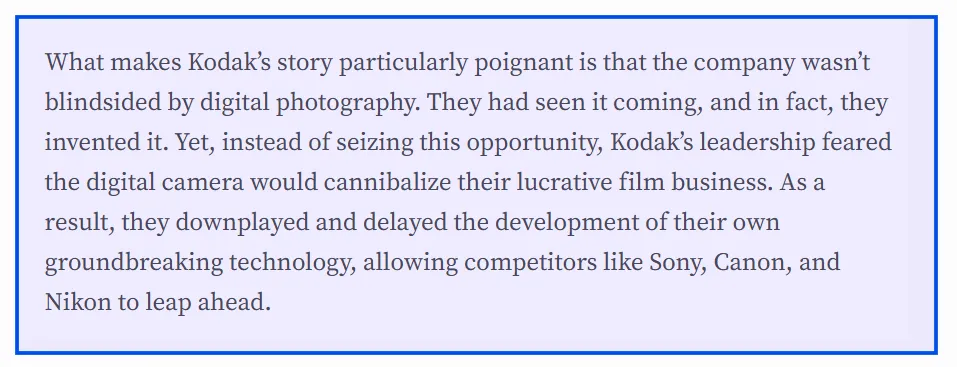
Also, Myspace dominated early social media before Facebook redefined the category.
These examples show how legacy scale can become a liability when smaller competitors move faster. Today’s Fortune 500s face the same risks: new entrants can chip away at share by exploiting slow decision cycles or rigid structures.
Markets evolve fast. Companies relying on outdated processes risk losing share to competitors investing in AI, automation, and digital platforms. Digital revenue continues to outpace traditional channels.
And these revenue shifts from traditional retail to digital revenue channels keep accelerating.
Staying static can lead to shrinking market share, stale brand innovation, and weaker customer engagement. Leaders must leverage business transformation to capture digital revenue and protect brand presence.
Fortune 500 brands like Nike or Amazon are integrating AI, automation, and immersive experiences to drive real results – but we’ll discuss these strategies below.
The point is: if you’re not evolving, your competitors are.
When we partnered with Nuun, a Nestlé Health Science brand, their acquisition model was stuck in the old performance loop. It was efficient, but flat.
We saw an opportunity to transform the way they went to market by building a creator-led strategy that brought authenticity and cultural relevance into every touchpoint.
We didn’t treat creators as one-off influencers, either.
We built a system that scaled across Nestlé’s broader portfolio:
In total, we supported 10+ NHS brands under this new model, proving the playbook works across categories.
This is what marketing transformation looks like in practice.
You have to rethink acquisition itself.
For Nuun, the shift from legacy performance to creator-led growth re-anchored the brand in culture, drove measurable efficiency, and set them up for long-term relevance.
And this is just one example.
We manage millions in monthly spend for Fortune 500 brands, helping them rewire their go-to-market strategies for speed, efficiency, and authenticity.
If a heritage company like Nestlé can move fast and win in a creator-driven economy, so can any large enterprise willing to transform.
That brings us to the next point:
When it comes to driving growth and staying ahead, CMOs are playing a major role. From harnessing AI and data to coordinating cross-functional teams, these leaders are turning marketing into a strategic powerhouse that fuels business transformation.
Full-time or fractional Chief Marketing Officers (CMOs) are now like conductors, leading cross-functional growth within their organizations. They are moving away from a narrow focus on brand campaigns and promotional activities.
Instead, CMOs collaborate with various teams, including , research and development, customer service, supply chain, and HR.
The point is to ensure marketing is aligned with product delivery, talent capabilities, and customer experience.
Besides, according to research from EY and Oxford, putting humans at the center of transformation can improve the odds of success by 2.6 times. Solid CMOs know how to do that very well.
CMOs can also ensure that your marketing actions align closely with broader business transformation goals.
Of course, they help shape strategies that involve customer analytics, enhancements to digital platforms, and insights into competitive category dynamics.
A CMO needs to make sure all marketing tools, like marketing technology, AI, and analytics, work together and support the overall business strategy.
Strong collaboration between the CMO, IT, and operations teams allows initiatives like product launches, AR campaigns, or virtual events to move quickly and deliver results.
CMOs shape how a company experiments with new ideas and technologies. They’re actually deciding where to bet on disruptive tech. The U.S. generative AI in marketing market is growing at 31.7% CAGR through 2030, and leaders who move early are already seeing advantages.
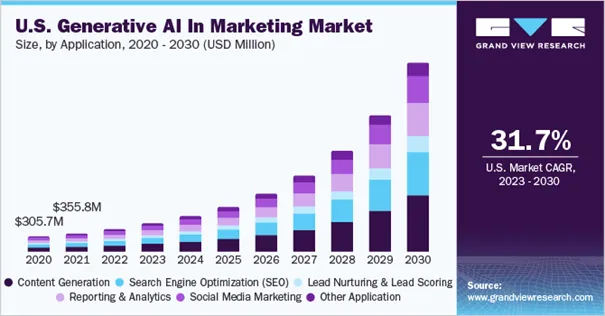
Take content and SEO.
Instead of waiting for agencies to deliver, CMOs are using AI-powered content engines to cut production time in half (or more) and redirect spend into distribution.
In social, brands are piloting AI-driven video generation and copy testing, which lets them run 100 creative variants where before they could only afford five.
Partnerships are the accelerator.
Pairing with startups or AI vendors lets CMOs experiment in controlled pilots. For example, they can test automated lead scoring or implement AI-based reporting without disrupting core operations.
The smartest brands treat these as sprints: measure NPS lift, engagement rates, or sales cycle reduction in 90 days, then scale what works.
This is the difference between brands that are experimenting their way into new revenue streams and those that will be left paying more for the same results as the market races ahead.
Every successful marketing transformation stands on a few key pillars. From putting customers first to using data smartly and modernizing technology, these foundations help brands stay agile, innovative, and ready for whatever the market throws at them.
Customer-centricity guides all decisions. Companies that are customer-centric are 60% more profitable than those that aren’t.
But customer-centricity only matters if it’s operationalized. Fortune 500 leaders link NPS, CES, and retention metrics directly to executive scorecards.
To get an edge, big organizations also map customer journeys across digital touch points, in-store experiences, social, customer service, and post-purchase phases. They gather data via customer analytics, then use that insight to tailor experiences.
That’s exactly what over half of customers want, according to Zendesk:
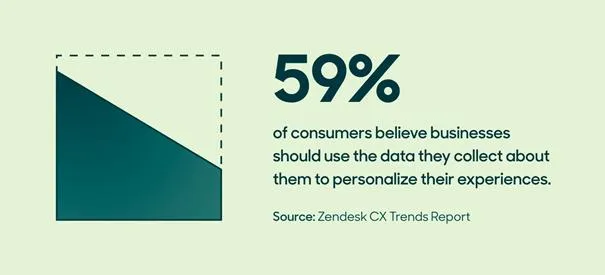
For example, Best Buy tied store-level NPS to manager bonuses and reversed a sales decline into multi-year growth.
Delta rolled out its AI chatbot Ask Delta to handle basics like check-in and flight searches, which cut call center volume by about 20%.
And it’s not just Delta. Across the airline industry, AI tools are trimming handle times by 25–30% and boosting satisfaction scores by roughly 15%
Major companies collect large volumes of data, including transactional, behavioral, logistics, and social information. They use this data to power predictive analytics and identify market patterns.
Predictive models make it easier to anticipate stock issues, reduce waste, and keep customers satisfied.
That’s why the predictive analytics market now has an estimated value of $22.22 billion and 80% of companies are using predictive AI.

Analytics can also help forecast demand, understand customer preferences, and fine-tune operations. Your CMO, COO, and CFO can all take advantage of advanced tools to make smarter decisions.
For example, Walmart uses predictive analytics to forecast demand during hurricanes, automatically stocking flashlights, batteries, and even Pop-Tarts in the right regions. That ability to anticipate customer needs before they happen keeps revenue flowing while competitors fail.
Lastly, automation can handle repetitive tasks, freeing up time for teams to focus on growth, strategy, and improving the overall customer experience.
Pro tip: At Fieldtrip, we advise our clients to start by aligning on one high-impact predictive use case (like forecasting demand spikes, or linking churn scores to retention campaigns). Then, measure your ROI within a single quarter. That quick win builds momentum for bigger transformation.
Modern marketing runs on a stack that can ingest data in real time, unify identities, and activate audiences without breaking when volumes spike. The backbone is a cloud data warehouse plus a consent-first customer data layer that feeds every channel from one source of truth.
Here’s what we advise you to focus on in practice:
This leads to:
If you want to get this started, use our quick 90-day checklist:
From AI to AR to blockchain, technology is changing the way top brands connect with customers. Let’s look a little closer at the tools shaping the future of marketing.
AI and machine learning are changing how businesses reach and engage customers. Recommendation engines can analyze customer behavior to suggest products or services that match individual preferences, while predictive models anticipate needs before customers even ask.
Research shows that 80% of consumers are more likely to make a purchase if they have a personalized experience. 71% of customers now expect companies to provide deep levels of personalization.
Generative AI can create personalized emails, social media content, and chat responses for each customer, making communications more relevant and increasing engagement. Your teams can leverage these tools to deliver highly tailored experiences without adding significant overhead.
That’s why AI-based personalization is growing at a CAGR of 4.90%.

Nestlé, for example, is accelerating product innovation using a generative AI concept tool that reduces ideation cycles from six months to just six weeks.
AR filters let customers try products virtually, and interactive ads or digital showrooms make online browsing more engaging. Virtual venues provide a way to host events or showcase offerings without physical limits, while digital twins give shoppers a chance to explore stores remotely.
Using AR and virtual experiences adds fun and memorable moments that help customers connect with your brand.
Nike’s AR-powered “Nike Fit” feature lets customers measure their feet via smartphone, for instance. That’s how they can find the right shoe size and reduce online returns by up to 28%.